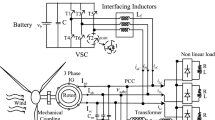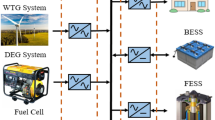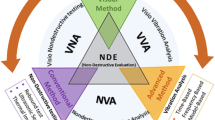Abstract
Wind turbine technology is well known around the globe as an eco-friendly and effective renewable power source. However, this technology often faces reliability problems due to structural vibration. This study proposes a smart semi-active vibration control system using Magnetorheological (MR) dampers where feedback controllers are optimized with nature-inspired algorithms. Proportional integral derivative (PID) and Proportional integral (PI) controllers are designed to achieve the optimal desired force and current input for MR the damper. PID control parameters are optimized using an Ant colony optimization (ACO) algorithm. The effectiveness of the ACO algorithm is validated by comparing its performance with Ziegler-Nichols (Z-N) and particle swarm optimization (PSO). The placement of the MR damper on the tower is also investigated to ensure structural balance and optimal desired force from the MR damper. The simulation results show that the proposed semi-active PID-ACO control strategy can significantly reduce vibration on the wind turbine tower under different frequencies (i.e., 67%, 73%, 79% and 34.4% at 2 Hz, 3 Hz, 4.6 Hz and 6 Hz, respectively) and amplitudes (i.e. 50%, 58% and 67% for 50 N, 80 N, and 100 N, respectively). In this study, the simulation model is validated with an experimental study in terms of natural frequency, mode shape and uncontrolled response at the 1st mode. The proposed PID-ACO control strategy and optimal MR damper position is also implemented on a lab-scaled wind turbine tower model. The results show that the vibration reduction rate is 66% and 73% in the experimental and simulation study, respectively, at the 1st mode.
Similar content being viewed by others
References
Bargi K, Dezvareh R and Mousavi SA (2016), “Contribution of Tuned Liquid Column Gas Dampers to the Performance of Offshore Wind Turbines under Wind, Wave, and Seismic Excitations,” Earthquake Engineering and Engineering Vibration, 15(3): 551–561.
Bottasso CL, Croce A, Gualdoni F and Montinari P (2016), “Load Mitigation for Wind Turbines by a Passive Aeroelastic Device,” Journal of Wind Engineering and Industrial Aerodynamics, 148: 57–69.
Boubertakh H, Tadjine M, Glorennec PY and Labiod S (2009), “Tuning Fuzzy PID Controllers using Ant Colony Optimization,” Med: 2009 17th Mediterranean Conference on Control & Automation, 1–3: 13–18.
Brodersen ML, Bjorke AS and Hogsberg J (2017), “Active tuned mass damper for damping of offshore wind turbine vibrations,” Wind Energy, 20(5): 783–796.
Caterino N, Georgakis CT, Occhiuzzi A and Spizzuoco M (2016), “Real-Time Monitoring and Structural Control of a Wind Turbine using a Rocking System,” 2016 IEEE Workshop on Environmental, Energy, and Structural Monitoring Systems (Eesms).
Chen JB, Liu YK and Bai XY (2015), “Shaking Table Test and Numerical Analysis of Offshore Wind Turbine Tower Systems Controlled by TLCD,” Earthquake Engineering and Engineering Vibration, 14(1): 55–75.
Chiha I, Liouane N and Borne P (2012), “Tuning PID Controller Using Multiobjective Ant Colony Optimization,” Applied Computational Intelligence and Soft Computing, 2012: 7.
Colwell S and Basu B (2009), “Tuned Liquid Column Dampers in Offshore Wind Turbines for Structural Control,” Engineering Structures, 31: 358–368.
Dorigo M, Maniezzo V and Colorni A (1996), “Ant System: Optimization by a Colony of Cooperating Agents,” IEEE Transactions on Systems Man and Cybernetics Part B-Cybernetics, 26(1): 29–41.
Enevoldsen I and Mørk K (1996), “Effects of a Vibration Mass Damper in a Wind Turbine Tower,” Mechanics of Structures and Machines, 24: 155–187.
Etedali S, Sohrabi MR and Tavakoli S (2013a), “Optimal PD/PID Control of Smart Base Isolated Buildings Equipped with Piezoelectric Friction Dampers,” Earthquake Engineering and Engineering Vibration, 12(1): 39–54.
Etedali S, Sohrabi MR and Tavakoli S (2013b), “An Independent Robust Modal PID Control Approach for Seismic Control of Buildings,” Journal of Civil Engineering and Urbanism, 3(5): 279–291.
Etedali S, Tavakoli S and Sohrabi MR (2016), “Design of a Decoupled PID Controller via MOCS for Seismic Control of Smart Structures,” Earthquakes and Structures, 10(5): 1067–1087.
Etedali S and Tavakoli S (2017), “PD/PID Controller Design for Seismic Control of High-Rise Buildings Using Multi-Objective Optimization: A Comparative Study with LQR Controller,” Journal of Earthquake and Tsunami, 11(03): 1750009.
Etedali S, Zamani A-A and Tavakoli S (2018), “A GBMO-Based PI λ D μ controller for vibration mitigation of seismic-excited structures,” Automation in Construction, 87: 1–12.
Fei Z, Jinting W, Feng J and Liqiao L (2019), “Control Performance Comparison Between Tuned Liquid Damper and Tuned Liquid Column Damper Using Real-Time Hybrid Simulation,” Earthquake Engineering and Engineering Vibration, 18(3): 695–701.
Genov J, Gilev B, Slavchev Y and Venkov G (2010), “Modeling and Control of Wind Turbine Tower Vibrations,” Applications of Mathematics in Engineering and Economics, 1293: 30−+.
Guclu R (2006), “Sliding Mode and PID Control of a Structural System Against Earthquake,” Mathematical and Computer Modelling, 44(1): 210–217.
Guclu R and Yazici H (2009), “Seismic-Vibration Mitigation of a Nonlinear Structural System with an ATMD Through a Fuzzy PID Controller,” Nonlinear Dynamics, 58(3): 553–564.
Heidari AH, Etedali S and Javaheri-Tafti MR (2018), “A Hybrid LQR-PID Control Design for Seismic Control of Buildings Equipped with ATMD,” Frontiers of Structural and Civil Engineering, 12(1): 44–57.
Ho C, Lang ZQ, Sapinski B and Billings SA (2013), “Vibration Isolation Using Nonlinear Damping Implemented by a Feedback-Controlled MR Damper,” Smart Materials and Structures, 22(10).
Housner GW, Bergman LA, Caughey TK, Chassiakos AG, Claus RO, Masri SF, Skelton RE, Soong TT, Spencer BF and Yao JTP (1997), “Structural Control: Past, Present, and Future,” Journal of Engineering Mechanics, 123: 897971.
Karimi H, Zapateiro M and Luo N (2010), “Semiactive Vibration Control of Offshore Wind Turbine Towers with Tuned Liquid Column Dampers Using H∞ Output Feedback Control,” IEEE International Conference on Control Applications, 2245–2249.
Kirkegaard PH, Nielsen SRK, Poulsen BL, Andersen J, Pedersen LH and Pedersen BJ (2002), “Semiactive Vibration Control of a Wind Turbine Tower Using an MR Damper,” Proceedings of The Fifth European Conference on Structural Dynamics: 1575–1580.
Krenk S, Svendsen MN and Høgsberg J (2012), “Resonant Vibration Control of Three-Bladed Wind Turbine Rotors,” AIAA Journal, 50: 148–161.
Laalej H, Lang ZQ, Sapinski B and Martynowicz P (2012), “MR Damper Based Implementation of Nonlinear Damping for a Pitch Plane Suspension System,” Smart Materials and Structures, 21(4).
Lackner MA and Rotea MA (2011), “Passive Structural Control of Offshore Wind Turbines,” Wind Energy, 14: 373–388.
Maldonado V, Boucher M, Ostman R and Amitay M (2009), “Active Vibration Control of a Wind Turbine Blade Using Synthetic Jets,” International Journal of Flow Control, 1: 227–238.
Marinaki M, Marinakis Y and Stavroulakis GE (2011), “Vibration Control of Beams with Piezoelectric Sensors and Actuators Using Particle Swarm Optimization,” Expert Systems with Applications, 38(6): 6872–6883.
Martynowicz P (2014), “Development of Laboratory Model of Wind Turbine’s Tower-Nacelle System with Magnetorheological Tuned Vibration Absorber,” Solid State Phenomena, 208: 40–51.
Martynowicz P (2015), “Vibration Control of Wind Turbine Tower-Nacelle Model with Magnetorheological Tuned Vibration Absorber,” Journal of Vibration and Control: 1077546315591445.
Martynowicz P (2016), “Study of Vibration Control Using Laboratory Test Rig of Wind Turbine Tower-Nacelle System with MR Damper Based Tuned Vibration Absorber,” Bulletin of the Polish Academy of Sciences-Technical Sciences, 64(2): 347–359.
Mohamad M, Tokhi M and Omar M (2011), “Continuous Ant Colony Optimisation for Active Vibration Control of Flexible Beam Structures,” IEEE International Conference on Mechatronics, 803–808.
Murtagh PJ, Ghosh AB, Basu and Broderick BM (2008), “Passive Control of Wind Turbine Vibrations Including Blade/Tower Interaction and Rotationally Sampled Turbulence,” Wind Energy, 11: 305–317.
Oliveira F, Morais P and Suleman A (2015), “A Comparative Study of Semi-Active Control Strategies for Base Isolated Buildings,” Earthquake Engineering and Engineering Vibration, 14(3): 487–502.
Rahman M, Ong ZC, Chong WT, Julai S and Khoo SY (2015), “Performance Enhancement of Wind Turbine Systems with Vibration Control: A review,” Renewable & Sustainable Energy Reviews, 51: 43–54.
Rahman M, Ong ZC, Julai S, Ferdaus MM and Ahamed R (2017), “A Review of Advances in Magneto Rheological Dampers: Their Design Optimization and Applications,” Journal of Zhejiang University SCIENCE A, 18(12): 991–1010.
Ramezani M, Bathaei A and Ghorbani-Tanha AK (2018), “Application of Artificial Neural Networks in Optimal Tuning of Tuned Mass Dampers Implemented in High-Rise Buildings Subjected to Wind Load,” Earthquake Engineering and Engineering Vibration, 17(4): 903–915.
Spencer BF, Dyke SJ, Sain MK and Carlson JD (1997), “Phenomenological Model for Magnetorheological Dampers,” Journal of Engineering Mechanics-Asce, 123(3): 230–238.
Staino A and Basu B (2013), “Dynamics and Control of Vibrations in Wind Turbines with Variable Rotor Speed,” Engineering Structures, 56: 58–67.
Wait I, Yang ZJ, Chen G and Still B (2019), “Wind-Induced Instabilities and Monitoring of Wind Turbine,” Earthquake Engineering and Engineering Vibration, 18(2): 475–485.
Wang Q, Wang J and Ma K (2019), “Research on Semi-Active Control Method of a Building Structure Based on Non-Smooth Control,” Earthquake Engineering and Engineering Vibration, 18(2): 425–432.
Zamani A-A, Tavakoli S and Etedali S (2017a), “Control of Piezoelectric Friction Dampers in Smart Base-Isolated Structures Using Self-Tuning and Adaptive Fuzzy Proportional-Derivative Controllers,” Journal of Intelligent Material Systems and Structures, 28(10): 1287–1302.
Zamani A-A, Tavakoli S and Etedali S (2017b), “Fractional Order PID Control Design for Semi-Active Control of Smart Base-Isolated Structures: A Multi-Objective Cuckoo Search Approach,” ISA Transactions, 67: 222–232.
Zamani A-A, Tavakoli S and Sadeghi J (2018a), “Online Tuning of Fractional Order Fuzzy PID Controller in Smart Seismic Isolated Structures,” Bulletin of Earthquake Engineering, 16(7): 3153–3170.
Zamani A-A, Tavakoli S, Etedali S and Sadeghi J (2018b), “Adaptive Fractional Order Fuzzy Proportional-Integral-Derivative Control of Smart Base-Isolated Structures Equipped with Magnetorheological Dampers,” Journal of Intelligent Material Systems and Structures, 29(5): 830–844.
Zhang ZL, Nielsen SRK, Blaabjerg F and Zhou D (2014), “Dynamics and Control of Lateral Tower Vibrations in Offshore Wind Turbines by Means of Active Generator Torque,” Energies, 7(11): 7746–7772.
Author information
Authors and Affiliations
Corresponding author
Additional information
Supported by: University of Malaya Research under Grant No. RP013B-15SUS, Postgraduate Research Fund (PG098-2015A)
Rights and permissions
About this article
Cite this article
Rahman, M., Ong, Z.C., Chong, W.T. et al. Smart Semi-active PID-ACO control strategy for tower vibration reduction in Wind Turbines with MR damper. Earthq. Eng. Eng. Vib. 18, 887–902 (2019). https://doi.org/10.1007/s11803-019-0541-6
Received:
Accepted:
Published:
Issue Date:
DOI: https://doi.org/10.1007/s11803-019-0541-6




